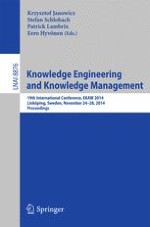2014 | Buch
Knowledge Engineering and Knowledge Management
19th International Conference, EKAW 2014, Linköping, Sweden, November 24-28, 2014. Proceedings
herausgegeben von: Krzysztof Janowicz, Stefan Schlobach, Patrick Lambrix, Eero Hyvönen
Verlag: Springer International Publishing
Buchreihe : Lecture Notes in Computer Science
